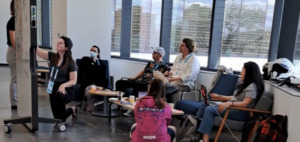Algonquin College students’ game design wins big
Posted on Thursday, June 1st, 2023
Online educational games are big business, but also a fun way for children to learn about important issues. A recent competition hosted by the Ingenium Innovation Lab has greenlit the creativity and passion of a group of Algonquin College students to create a fun and educational product for young learners.
learn about important issues. A recent competition hosted by the Ingenium Innovation Lab has greenlit the creativity and passion of a group of Algonquin College students to create a fun and educational product for young learners.
Their product, Artifice, is a climate action themed educational game, and was recently awarded $15,000 along with dedicated funding and mentorship to further develop the proof-of-concept into a marketable, educational product for youth. The game will be available to the public in 2024.
The proposed game offers users the opportunity to make small changes with big impacts on climate change. The cross-platform application invites players to explore environmental landscapes in Canada from coast to coast to coast as an animal character while learning about the threats to their survival due to climate change. Through gameplay, they have the power to change the habits that are ruining their habitat.
“We asked, how do we make a game kids want to play?” said graphic design student Karen Mendoza. “We wanted to give children a choice to learn at their own pace through play. Kids have access to all information and knowledge; they get to choose what they learn and when they learn it.”
Keeping their audience top of mind made a big difference to the judges.
“Their proposal was well rounded, they responded to criteria and their presentation was what we were looking for,” said Ryan Dodge, Chief Digital Officer at Ingenium. “They [the Artifice team] listened to feedback and kept the fun factor there. Out of all the projects, that fun element really came through. You can still have learning for children with fun. That’s the goal – put something in front of children that will lead to changes that will have a positive impact on the climate.”
“We were lucky enough to have a judge who was around ten and we spent lots of time talking to him,” said game development student Ken Hicks. “To see his reactions as we were flushing out ideas was huge. His level of excitement was a gauge as to if we were on the right track.”
“Our goal was to turn apathy into empathy through games,” said team member and game development student Ana Sophia Fryzek. The team worked to ensure different regions of the country were represented as well as different climate change challenges. Attention was also paid to accessibility and socio-economic situations to ensure most learners could play the game. Mendoza said other issues the team looked at included physical abilities, mobility issues, and visual impairment.
“We were adamant that all the things be true (within the game world) to make sure to really represent people in different parts of the country,” said graphic designer and team member Michel Pennington. “We wanted to expose kids to regions in Canada affected by climate change,” added team member and graphic design student Laura Salisbury.
Last month, the Ingenium Innovation Challenge brought together over 90 post-secondary students from across the science, technology, engineering, arts, mathematics and business landscape to compete and collaborate across 20 teams. Each presented an innovative and creative digital prototype designed to inspire Canadian youth aged 9-12 (grades 4-7) on actions they can take in their everyday lives to help mitigate the impacts of climate change.
Soon, Ingenium and the Artifice team will be meeting to make the game a reality. “We will work with them over the summer months to put together a calendar and schedule, to create roles and responsibilities,” said Dodge. “They have all the pieces to bring this (game) to release. This team has the full package, and we will work with them with expertise, content, programming, and design to get this launched in front of kids.”
For more information visit the Ingenium Innovation Lab.
- Posted in
- Words
- Tags: